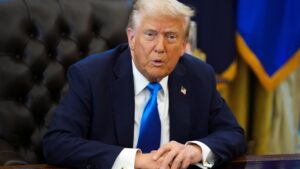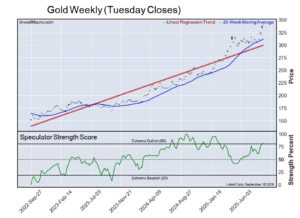Markets
We’ve given Fed governor Waller plenty of attention this year. He’s been the voice of the large minority inside the Fed who from the beginning of the year has been pushing to keep policy rates at their peak levels for longer. Markets had to gradually retrace from huge easing bets at the beginning of the year, guided by Waller’s “What’s the rush?” and “There’s still no rush” chorus. Backed by stubborn Q1 inflation figures and a strong labour market, this eventually resulted in a median FOMC forecast of just one 25 bps rate cut this year at the June policy meeting. Benign Q2 CPI prints and fear that we might reach a tipping point in the labour market – from pulling vacancies to effectively reducing headcount – tilted the market balance back in favour of more (at least two) and potentially even bigger (50 bps instead of 25 bps) policy rate cuts. Fed governors welcomed the data, but didn’t commit to a specific timing for pulling the trigger. Fed Waller yesterday joined this majority view. “Current data are consistent with achieving a soft landing, and I will be looking for data over the next couple months to buttress this view. While I don’t believe we have reached our final destination, I do believe we are getting closer to the time when a cut in the policy rate is warranted.” The change of heart from Fed governor Waller is significant and a confirmation towards recent market repricing. While the US 2-yr yield reversed intraday course on his comments (from +6 bps to eventually +2 bps), it’s telling that they didn’t trigger a test of the recent lows around 4.40%. We conclude that at least in the short run, sufficient (or even again too much) Fed policy easing has been discounting. Ceteris paribus, this 4.4% floor should be able to hold going into the July 31 FOMC meeting.
Dollar weakness was yesterday’s main trading theme, with technical breaks in USD/JPY (1.30) and EUR/USD (>1.0916). These moves occurred despite a modest yield rebound and an ongoing equity market correction. US tech-heavy Nasdaq posted its worst result YTD, correcting 2.77% lower. Hawkish trade/foreign policy comments by president-candidate Trump against Taiwan and the semiconductor sector played a role. EUR/GBP attempted a move below 0.84 after June CPI data (slightly) reduced odds of an August BoE rate cut (40% from 50%). A bang-in-line UK labour market report offers no directional guidance this morning. The ECB meeting is today’s key event. We expect ECB President Lagarde to hint at a potential 25 bps rate cut at the next September meeting. We don’t think that the outcome today will alter market pricing of quarterly rate cuts over the year ahead (Sep24, Dec24, Mar25, Jun25).
News & Views
The Australian labour market remains strong even as the unemployment rate rose from 4% to 4.1% in June. The economy in June added net 50.2k (net) jobs, with the gain mostly due to a second consecutive strong rise of full-time employment (43k). The rise in the unemployment rate mainly was the result from a higher participation rate. At 66.9% (from 66.8% in May) it nears the all-time record high of 67% (Nov 2023). Seasonally adjusted monthly hours worked rose by 0.8%. The Australian Bureau of Statistics said that “The employment-to-population ratio and participation rate both continue to be near their 2023 highs. This, along with the continued high level of job vacancies, suggests the labour market remains relatively tight, despite the unemployment rate being above 4% since April’. The Australian 2-y bond yield rebounds 3.2 bps. Markets currently attach a > 25% probability to the RBA raising its policy rate at the August meeting. June CPI inflation data (July 31) will be important input. The Aussie dollar rebounds slightly after a recent (mild) setback, trading at AUD/USD 0.674.
Japan in June returned to a trade surplus of JPY 224bn compared to a JPY 1220bn deficit the previous month as (nominal) exports rose more than imports. Exports added 5.4% Y/Y while imports only rose 3.2%. Even so, growth in both cases slowed substantially from May and also missed market expectations both for exports (7.2%) and imports (9.6%). Both nominal data were for an important part due to a sharp weakening of the yen compared to last year. In volume terms, merchandise exports declined 6.2% Y/Y with imports where 8.9% lower, suggesting still mediocre domestic demand. Japan recorded a JPY 870bn trade surplus with the US while it had a deficit of JPY 335,49bn with China and a deficit of JPY 185.67bn with the EU.
Graphs
GE 10y yield
The ECB cut its key policy rates by 25 bps at the June policy meeting. A more bumpy inflation path in H2 2024, the EMU economy gradually regaining traction and the Fed’s higher for longer US strategy make follow-up moves difficult. Markets are coming to terms with that. Meanwhile, much of the save haven bids were reversed after the (first round in) the French elections. The 2.34%-2.4% support zone looks solid.
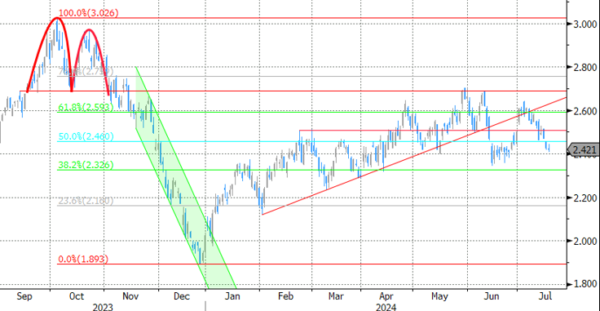
US 10y yield
The Fed indicated that it needs more evidence to lower its policy rate. June dots suggested one move in 2024 and four next year. Disappointing ISM and back-to-back downward CPI surprises put the US money market back on (at least) two rate cuts this year (September/December). The US 10-yr yield tests the recent lows and the downside of the downward trend channel in the 4.2% area.
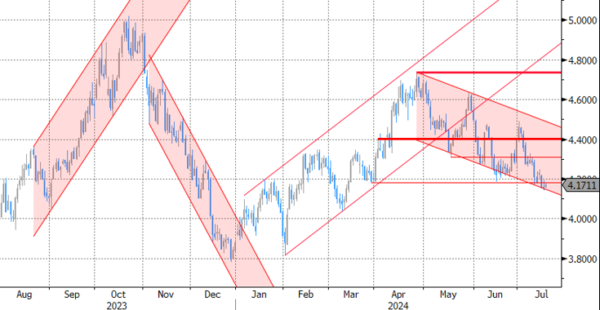
EUR/USD
EUR/USD is testing the topside of the 1.06-1.09 range as the dollar loses interest rate support at stealth pace. Markets consider a September rate cut a done deal and only need confirmation from high-ranked Fed officials. In the meantime, the euro got rid of the (French) political risk premium. Risks of a topside break are high, bringing the psychologic 1.10 and the December 2023 top at 1.1139 on the radar.
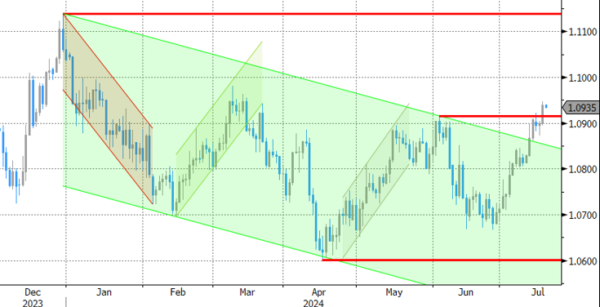
EUR/GBP
Debate at the BOE is focused at the timing of rate cuts. May headline inflation returned to 2%, but core measures weren’t in line with inflation sustainably returning to target any time soon. Still some BoE members at the June meeting appeared moving closer to a rate cut. Labour has yet to reveal its policy plans after securing a landslide election victory. EUR/GBP 0.84 is support is being tested.









